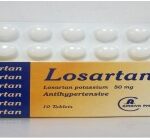What Happens If You Miss A Dose Of Losartan?

Generally, blood pressure is the measure of the force of blood pushing against blood vessel walls. The heart pumps blood into blood vessels, which carry the blood throughout the body. High blood pressure, also called hypertension, is dangerous because it makes the heart work harder to pump blood out to the body and contributes to the hardening of the arteries, or atherosclerosis, stroke, kidney disease, and heart failure.
Treating high blood pressure early is important in preventing these and other problems. Dozens of different medications can help treat high blood pressure. These drugs are called antihypertensives. They’re divided into many different categories, each of which works differently and causes different side effects.
Most adults with hypertension in the United States do not have their hypertension under control (92.1 million). This includes all 24.3 million adults who are recommended lifestyle modifications only and 67.8 million adults who are recommended lifestyle modifications and prescription medication. In this article, we shall be looking at Losartan and dosage compliance.
What Is Losartan?
Losartan is a prescription drug that belongs to a group of drugs called angiotensin II receptor antagonists. It keeps blood vessels from narrowing, which lowers blood pressure and improves blood flow.
Losartan is used to treat high blood pressure (hypertension). It is also used to lower the risk of stroke in certain people with heart disease. Losartan is used to slow long-term kidney damage in people with type 2 diabetes who also have high blood pressure.
How Losartan works
Losartan works by blocking the action of angiotensin II, a chemical in your body that causes your blood vessels to tighten and narrow. Losartan helps relax and widen your blood vessels. This lowers your blood pressure.
This action helps treat high blood pressure as well as the other two conditions. Losartan is usually prescribed for high blood pressure and left ventricular hypertrophy (LVH) increases your risk of stroke, so lower blood pressure reduces your risk.
Lower blood pressure also reduces your risk of kidney damage. This is because high blood pressure raises your risk of kidney damage that’s caused by the high blood sugar levels linked with diabetes.
How should this medicine be used?
Losartan comes as a tablet to take by mouth. It is usually taken once or twice a day with or without food. To help you remember to take Losartan, take it at around the same time(s) every day. Follow the directions on your prescription label carefully, and ask your doctor or pharmacist to explain any part you do not understand. Take Losartan exactly as directed. Do not take more or less of it or take it more often than prescribed by your doctor.
• For oral dosage form (tablets):
o For high blood pressure:
Adults—At first, 50 milligrams (mg) once a day. Your doctor may adjust your dose as needed.
Children 6 to 16 years of age—Dose is based on body weight and must be determined by your doctor. The starting dose is usually 0.7 milligram (mg) per kilogram (kg) of body weight per day. Your doctor may adjust your dose as needed. However, the dose is usually not more than 50 mg per day.
Children younger than 6 years of age—Use and dose must be determined by your doctor.
o For lowering the risk of stroke in patients with high blood pressure and enlargement of the heart:
Adults—At first, 50 milligrams (mg) once a day. Your doctor may adjust your dose and add another medicine based on your blood pressure response.
Children—Use and dose must be determined by your doctor.
o For diabetic nephropathy:
Adults—At first, 50 milligrams (mg) once a day. Your doctor may adjust your dose based on your blood pressure response.
Children—Use and dose must be determined by your doctor.
Your doctor will probably start you on a low dose of Losartan and gradually increase your dose.
If your child can not swallow a tablet, talk to your doctor or pharmacist. The pharmacist can prepare a liquid form of this medication for your child.
Losartan controls high blood pressure but does not cure it. Your blood pressure may decrease during the first week of your treatment, but it may take 3 to 6 weeks for you to notice the full benefit of Losartan. Continue to take Losartan even if you feel well. Do not stop taking Losartan without talking to your doctor.
Ask your pharmacist or doctor for a copy of the manufacturer’s information for the patient. Also, talk to your doctor about the possible risks of using this medication for your condition.
What Happens If You Miss A Dose Of Losartan?
If you forget to take a dose of Losartan, take it as soon as you remember. However, if it is almost time for your next dose, skip the missed Losartan dose and go back to your regular dosing schedule.
The typical starting dosage is 50 mg once daily. Dosages range between 25 and 100 mg per day. You take losartan once or twice per day. Do not take double Losartan doses to make up for the dose you missed.
Studies indicate that compliance with a prescribed medical regimen can reduce morbidity and or deaths from hypertension. Regularly fill prescriptions and ask the pharmacist any questions you have.
What are the side effects of Losartan?
Common side effects of Losartan include:
• cold or flu symptoms such as stuffy nose, sneezing, sore throat, fever, and cough
• diarrhea
• dizziness
• headache
• leg or back pain
• muscle cramps
• sleep problems (insomnia)
• stomach pain
• tiredness, and
Tell your doctor if you experience serious side effects of Losartan including pain or burning when you urinate; pale skin, lightheadedness, shortness of breath, rapid heart rate, trouble concentrating; wheezing, chest pain; drowsiness, confusion, mood changes, increased thirst, loss of appetite, nausea and vomiting; swelling, weight gain, urinating less than usual or not at all; or high potassium (slow heart rate, weak pulse, muscle weakness, tingly feeling).
Losartan Interactions
Tell your doctor about all medicines you use, and those you start or stop using during your treatment with Losartan, especially:
• a diuretic or “water pill”;
• other blood pressure medications;
• lithium;
• celecoxib; or
• aspirin or other NSAIDs (non-steroidal anti-inflammatory drugs) such as ibuprofen (Advil, Motrin), naproxen (Aleve), celecoxib, diclofenac, indomethacin, meloxicam, and others.
This list is not complete. Other drugs may interact with Losartan, including prescription and over-the-counter medicines, vitamins, and herbal products. Not all possible interactions are listed in this medication guide.





